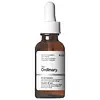What's inside
What's inside
 Key Ingredients
Key Ingredients

 Benefits
Benefits

 Concerns
Concerns

No concerns
 Ingredients Side-by-side
Ingredients Side-by-side

Water
Skin ConditioningButylene Glycol
HumectantNicotiana Benthamiana Hexapeptide-40 Sh-Oligopeptide-1
Skin ConditioningNicotiana Benthamiana Hexapeptide-40 Sh-Polypeptide-76
Skin ConditioningNicotiana Benthamiana Octapeptide-30 Sh-Oligopeptide-2
Skin ConditioningWater, Butylene Glycol, Nicotiana Benthamiana Hexapeptide-40 Sh-Oligopeptide-1, Nicotiana Benthamiana Hexapeptide-40 Sh-Polypeptide-76, Nicotiana Benthamiana Octapeptide-30 Sh-Oligopeptide-2, Sclerotium Gum, Glycerin, Trisodium Ethylenediamine Disuccinate, Citric Acid, Sodium Citrate, Phenoxyethanol, Chlorphenesin
Water
Skin ConditioningC15-19 Alkane
SolventCetyl Alcohol
EmollientGlyceryl Stearate
Emollient3-O-Ethyl Ascorbic Acid
Skin ConditioningCoco-Caprylate
EmollientGlycerin
HumectantMangifera Indica Seed Butter
Skin ConditioningSqualane
EmollientTheobroma Cacao Seed Butter
EmollientButyrospermum Parkii Butter
Skin ConditioningHexylresorcinol
AntimicrobialBetaine
HumectantStearic Acid
CleansingMannitol
HumectantSodium Levulinate
Skin ConditioningTriolein
Skin ConditioningSclerotium Gum
Emulsion StabilisingCetyl Hydroxyethylcellulose
Emulsion StabilisingGlyceryl Caprylate
EmollientDimethyl Isosorbide
SolventPropanediol
SolventSodium Anisate
AntimicrobialGlyceryl Dioleate
EmollientCeramide NP
Skin ConditioningXanthan Gum
EmulsifyingHydroxyapatite
AbrasiveSodium Hyaluronate
HumectantSodium Phytate
Chamomilla Recutita Flower Extract
MaskingTocopherol
AntioxidantChlorella Vulgaris Extract
Skin ConditioningHydroxypinacolone Retinoate
Skin ConditioningRetinal
Skin ConditioningLecithin
EmollientLactic Acid
BufferingAcetyl Tetrapeptide-9
Skin ConditioningAcetyl Tetrapeptide-11
Skin ConditioningCitric Acid
BufferingPotassium Sorbate
PreservativeWater, C15-19 Alkane, Cetyl Alcohol, Glyceryl Stearate, 3-O-Ethyl Ascorbic Acid, Coco-Caprylate, Glycerin, Mangifera Indica Seed Butter, Squalane, Theobroma Cacao Seed Butter, Butyrospermum Parkii Butter, Hexylresorcinol, Betaine, Stearic Acid, Mannitol, Sodium Levulinate, Triolein, Sclerotium Gum, Cetyl Hydroxyethylcellulose, Glyceryl Caprylate, Dimethyl Isosorbide, Propanediol, Sodium Anisate, Glyceryl Dioleate, Ceramide NP, Xanthan Gum, Hydroxyapatite, Sodium Hyaluronate, Sodium Phytate, Chamomilla Recutita Flower Extract, Tocopherol, Chlorella Vulgaris Extract, Hydroxypinacolone Retinoate, Retinal, Lecithin, Lactic Acid, Acetyl Tetrapeptide-9, Acetyl Tetrapeptide-11, Citric Acid, Potassium Sorbate
 Reviews
Reviews

Ingredients Explained
These ingredients are found in both products.
Ingredients higher up in an ingredient list are typically present in a larger amount.
Citric Acid is an alpha hydroxy acid (AHA) naturally found in citrus fruits like oranges, lemons, and limes.
Like other AHAs, citric acid can exfoliate skin by breaking down the bonds that hold dead skin cells together. This helps reveal smoother and brighter skin underneath.
However, this exfoliating effect only happens at high concentrations (20%) which can be hard to find in cosmetic products.
Due to this, citric acid is usually included in small amounts as a pH adjuster. This helps keep products slightly more acidic and compatible with skin's natural pH.
In skincare formulas, citric acid can:
While it can provide some skin benefits, research shows lactic acid and glycolic acid are generally more effective and less irritating exfoliants.
Most citric acid used in skincare today is made by fermenting sugars (usually from molasses). This synthetic version is identical to the natural citrus form but easier to stabilize and use in formulations.
Read more about some other popular AHA's here:
Learn more about Citric AcidGlycerin is already naturally found in your skin. It helps moisturize and protect your skin.
A study from 2016 found glycerin to be more effective as a humectant than AHAs and hyaluronic acid.
As a humectant, it helps the skin stay hydrated by pulling moisture to your skin. The low molecular weight of glycerin allows it to pull moisture into the deeper layers of your skin.
Hydrated skin improves your skin barrier; Your skin barrier helps protect against irritants and bacteria.
Glycerin has also been found to have antimicrobial and antiviral properties. Due to these properties, glycerin is often used in wound and burn treatments.
In cosmetics, glycerin is usually derived from plants such as soybean or palm. However, it can also be sourced from animals, such as tallow or animal fat.
This ingredient is organic, colorless, odorless, and non-toxic.
Glycerin is the name for this ingredient in American English. British English uses Glycerol/Glycerine.
Learn more about GlycerinSclerotium Gum is a polysaccharide gum made by the fungus, Sclerotium rolfssii. It is similar to xanthan gum.
In cosmetics, Sclerotium Gum is used to thicken the texture and to help stabilize other ingredients.
As an emulsifier, Sclerotium Gum helps prevent ingredients from separating, such as water and oil.
Learn more about Sclerotium GumWater. It's the most common cosmetic ingredient of all. You'll usually see it at the top of ingredient lists, meaning that it makes up the largest part of the product.
So why is it so popular? Water most often acts as a solvent - this means that it helps dissolve other ingredients into the formulation.
You'll also recognize water as that liquid we all need to stay alive. If you see this, drink a glass of water. Stay hydrated!
Learn more about Water